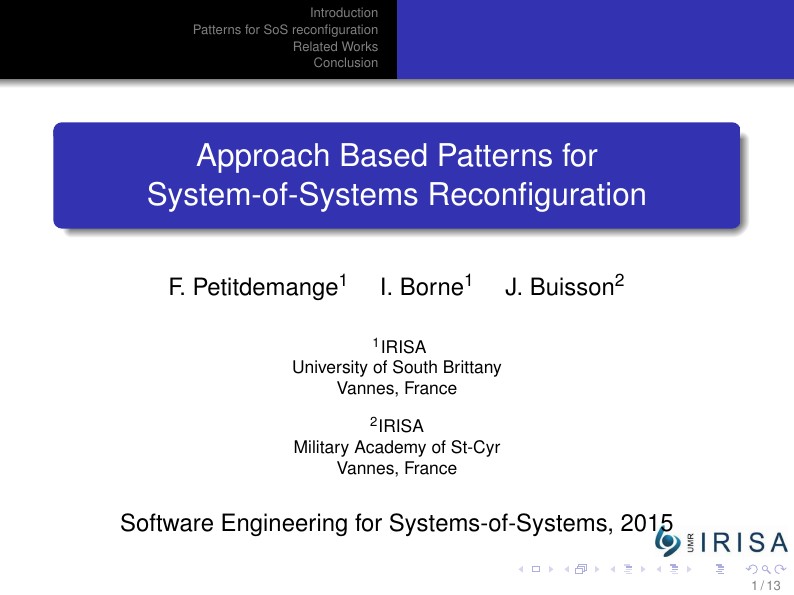
Patterns for SoS Reconfiguration
Author:
petitdemange
Last Updated:
11 anni fa
License:
Creative Commons CC BY 4.0
Abstract:
presentation sesos 2015

\begin
Discover why over 20 million people worldwide trust Overleaf with their work.
presentation sesos 2015

\begin
Discover why over 20 million people worldwide trust Overleaf with their work.
\documentclass{beamer}
\usepackage{pgfpages}
%\setbeameroption{show notes}
%\setbeameroption{show notes on second screen=right}
\mode<presentation> {
\usetheme{Warsaw}
% ou autre ...
\setbeamercovered{transparent}
% ou autre chose (il est également possible de supprimer cette ligne)
}
\usepackage[french]{babel}
\usepackage[latin1]{inputenc}
\usepackage{times}
\usepackage[T1]{fontenc}
\usepackage{tikz}
\pgfdeclareimage[height=0.5cm]{le-logo}{logo-irisa}
\logo{\pgfuseimage{le-logo}}
\setbeamertemplate{footline}[frame number]
%%%%%%%%%%%%%%%%%%%%%%%%%%%
\title[Patterns for SoS Reconfiguration]
{Approach Based Patterns for System-of-Systems Reconfiguration}
%\subtitle {ne compléter que si l'article possède un sous-titre}
\author[Franck, Petitdemange]
{F.~Petitdemange\inst{1} \and I.~Borne\inst{1} \and J.~Buisson\inst{2}}
\institute[]
{
\inst{1}%
IRISA\\
University of South Brittany\\
Vannes, France
\and
\inst{2}%
IRISA\\
Military Academy of St-Cyr\\
Vannes, France}
\date[SESOS 2015]
{Software Engineering for Systems-of-Systems, 2015}
\begin{document}
\begin{frame}
\titlepage
\end{frame}
\begin{frame}{Plan}
\tableofcontents
\end{frame}
\section{Introduction}
\subsection{SoS Engineering Process}
\begin{frame}{SoS Engineering Process}
%\includegraphics[scale=0.3, angle=-90]{construction-process}
\input{figures/fig_engineering-process}
\end{frame}
\subsection{SoSADL}
\begin{frame}{Architecture desciption language : SoSADL}
\begin{description}
\item[Constituent System (CS) :] have their own managerial and
operational independance while contributing to the global mission
of the SoS
\item[Mediator :] controled by the SoS. They belong to the
SoS. Mediateur are communicating element that specify, coordinate
the interaction beetween CSs and SoS control over them.
\item[Coalition :] a set of contraints about the CSs and
mediator required to accomplish a emergent behavior.
\end{description}
\end{frame}
\subsection{Context}
\begin{frame}{Emergency service SoS}
\begin{description}
\item[Mission :] preserve human life and material
\end{description}
\input{figures/fig_emergency-service-exemple}
\end{frame}
\section{Patterns for SoS reconfiguration}
\subsection{Motivation}
\begin{frame}{Need of architectural reconfiguration}
Cause :
\begin{itemize}
\item managerial and operational independance of the constituents
\end{itemize}
Consequence :
\begin{itemize}
\item architecture evolve continuesly
\end{itemize}
Problems :
\begin{itemize}
\item determine a set of reconfiguration' operations to maintain architectural pattern in the concrete architecture?
\item determine a set of reconfiguration' operations to make evolve the architectural pattern in a coherently way?
\end{itemize}
\end{frame}
\begin{frame}{Architectural pattern}
\includegraphics[angle=-90, scale=0.5]{pattern-emergency-service}
\end{frame}
\begin{frame}{Maintain architectural patterns}
\includegraphics[angle=-90, scale=0.4]{cas-maintain-pattern}
\end{frame}
\begin{frame}{Architectural pattern evolutions}
\includegraphics[angle=-90,scale=0.4]{cas-evolution-pattern}
\end{frame}
\subsection{Approach}
\begin{frame}{Patterns for reconfiguration}
Approach :
\begin{itemize}
\item use pattern approach to formalize a set of best practice to assist
reconfiguration
\end{itemize}
\begin{itemize}
\item based on dedicaded language (SoSADL), describe SoS architecture
pattern architectural taking into account SoS characteristics
\item express a set of reconfiguration operations associate to this
architectural pattern which can express for instance :when, how,
for which to add a new CS.
\end{itemize}
\end{frame}
\begin{frame}{Challenges}
\begin{itemize}
\item the choice of reconfiguration' operations in order to instanciate or reinstanciate the architectural pattern
%\item ...
\end{itemize}
\end{frame}
\section{Related Works}
\begin{frame}{}
\end{frame}
\section{Conclusion}
\begin{frame}{Challenge and Futur Work}
Challenge :
\begin{itemize}
\item
\end{itemize}
Futur Work :
\begin{itemize}
\item
\end{itemize}
\end{frame}
\end{document}